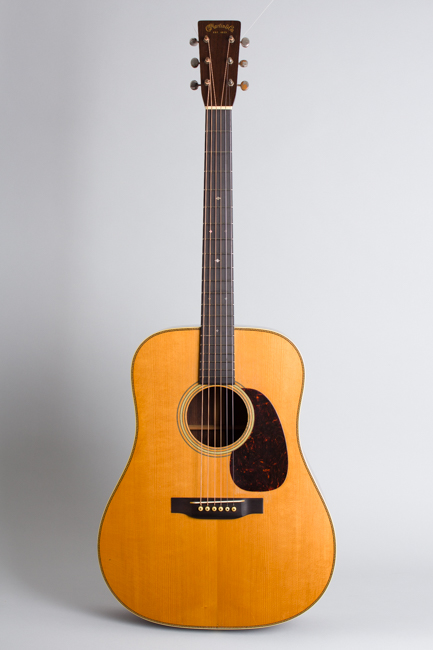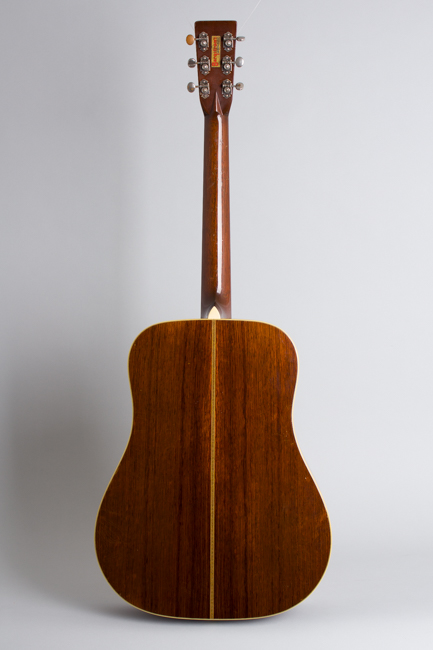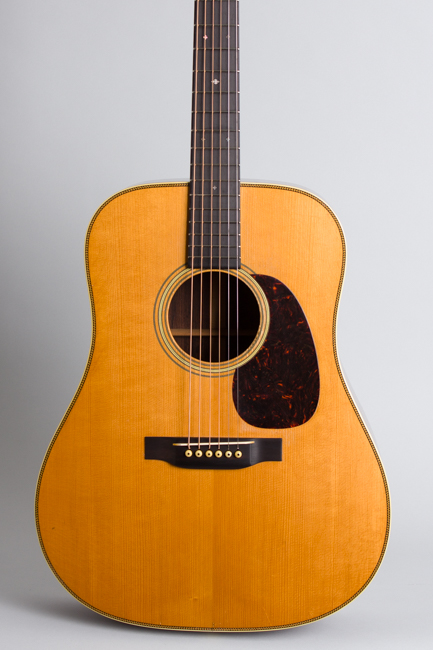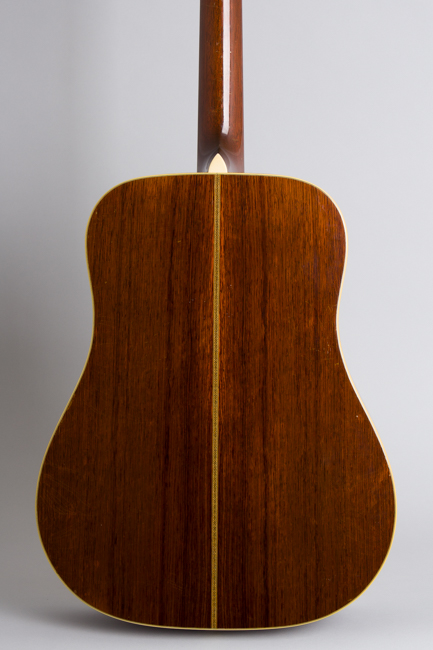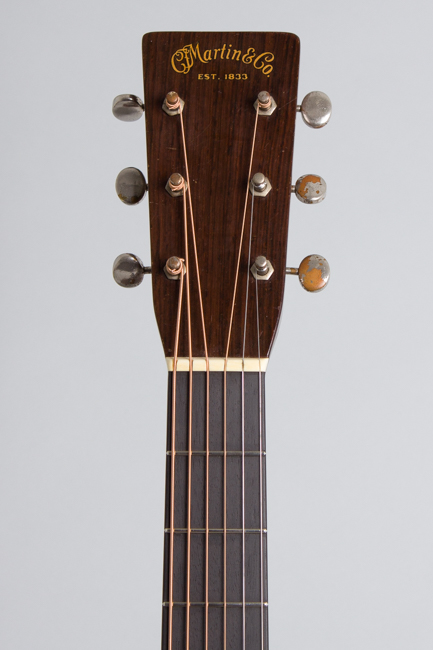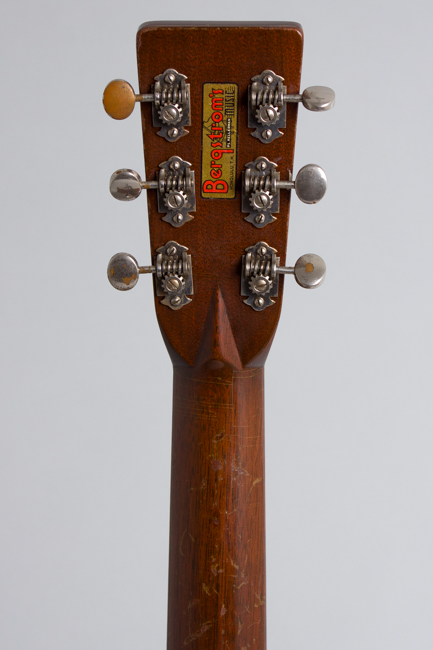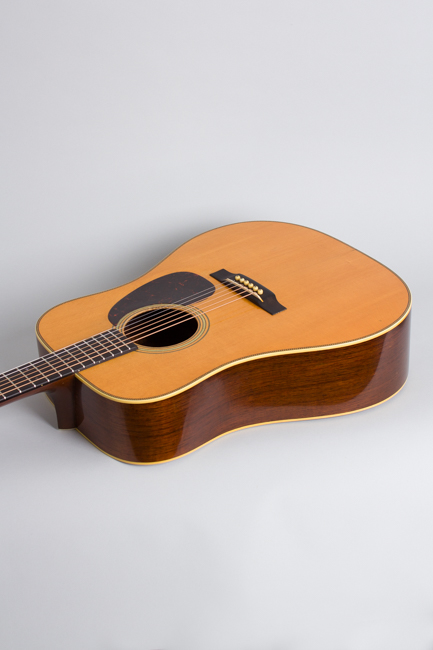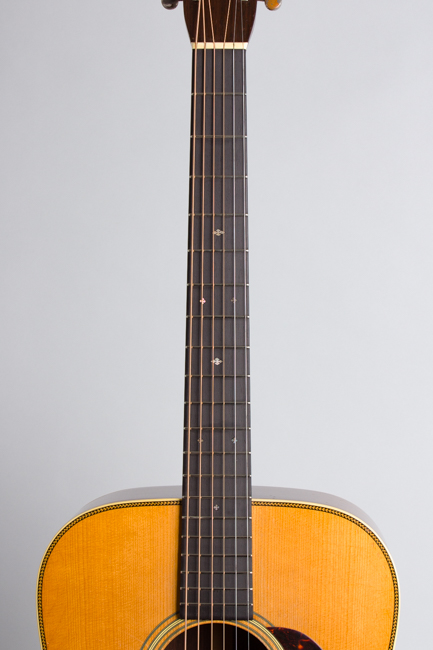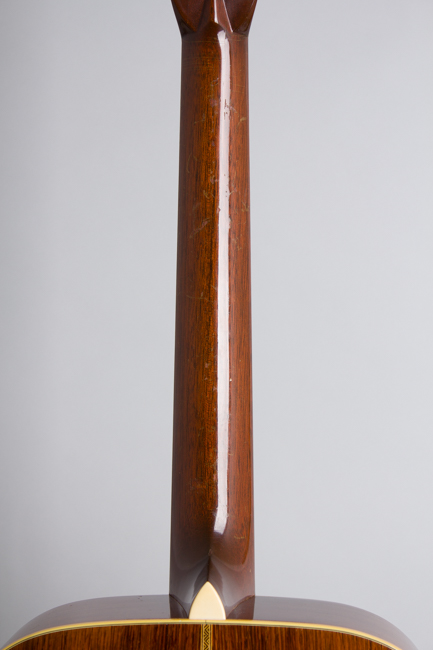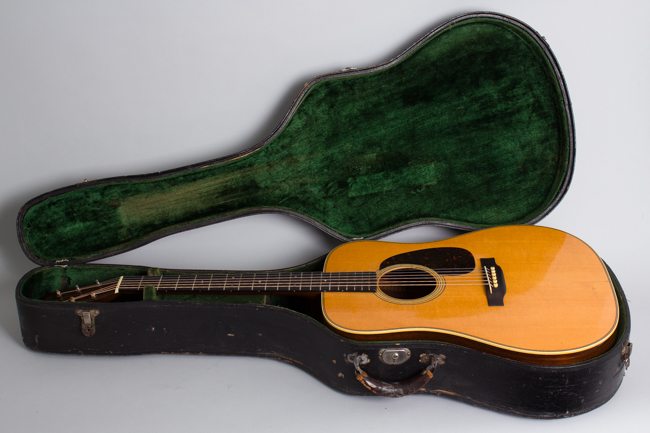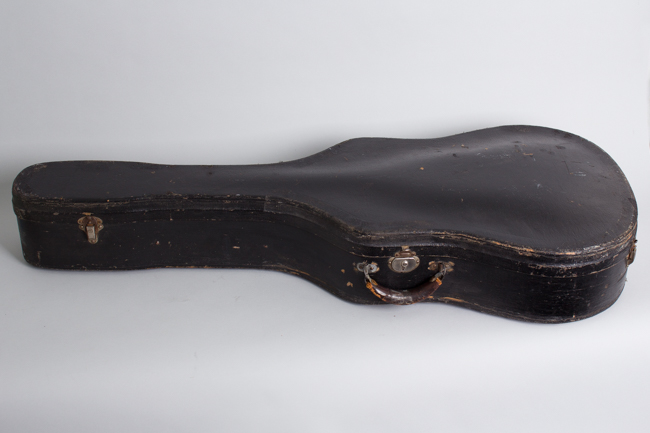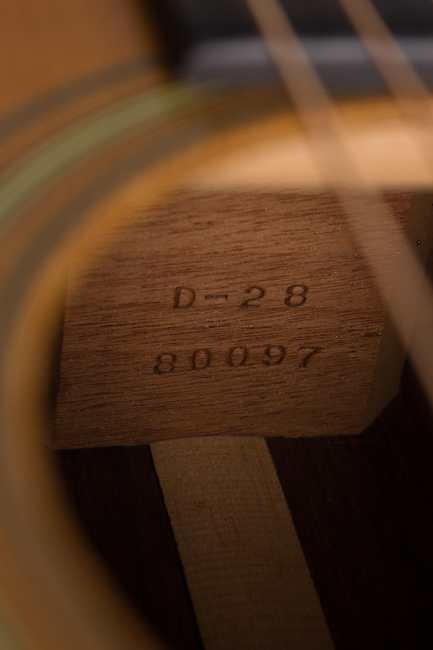C. F. Martin D-28 Flat Top Acoustic Guitar (1942)
This item has been sold.
Item # 10578
Prices subject to change without notice.
C. F. Martin D-28 Model Flat Top Acoustic Guitar (1942), made in Nazareth, PA, serial # 80097, natural lacquer finish, Brazilian rosewood back and sides, spruce top; mahogany neck with ebony fingerboard, original black hard shell case.
This is an amazingly well preserved example of a guitar that is simply a standard by which all others are judged: the Martin D-28 "herringbone". This example shows far less wear and repair than most, a fantastic survivor more than 80 years along. This early 1940s instrument still shows the original classic features of the model which have been widely imitated ever since.
This D-28 is from one of the first few batches guitars built in Nazareth during January 1942, just after the US entered WWII. Serial number 80013 was the last one logged for 1941; this D-28 carries 80097. These are often referred to as a "bone", after the namesake "herringbone" wood marquetry trim around the top. Whether this cosmetic feature has any affect on the sound is a hotly debated question; Martin stopped using it on their instruments by mid-1947 as their supply ran out. By then the D-28 had seen a number of other changes, most importantly the discontinuation of the scalloped top braces. The instruments of the 1940's and '50's evolved to have a different sonic character, but some players found they preferred the older ones, giving rise to a still-active cult..
The other features of this guitar are still classic prewar D-28 appointments. Although technically a "wartime" guitar (by about a month) it does not yet show any changes from WWII restrictions. The top bracing is the rearward shifted pattern adopted in 1939, still delicately scalloped with top construction lighter than the typical 1950's style. The back and sides are beautifully grained Brazilian rosewood, with more "striping" to the back than many period Style 28s. The top is lovely Appalachian spruce, the small "teardrop" shape pickguard just below the sound hole is made of tortoise celluloid. The ebony bridge is the typical Martin "belly" shape with a canted bone saddle.
The neck is mahogany with an unbound ebony fingerboard decorated with discreet slotted diamond pearl inlay. The peghead is faced in straight grained Brazilian rosewood with the "C.F. Martin & C." decal at the top. The neck profile is round backed but with a subtle "V" profile in the way the sides bear away from the center as it moves towards the nut. The neck still has the standard metal reinforcement; wartime restrictions on steel causing this to be deleted were not yet in place. The tuners are an openback Waverly style typical of the late pre-war period with round metal buttons.
Cosmetically this guitar shows only fairly light signs of play, at least compared to many other Martins of this period. Playing into the open mikes of radio studios and barn dance stages a guitar had to have the maximum of both depth and projection, and many Country and Western performers of the period (accent on "Western") found the Martin D-28 the best instrument available for this highly competitive musical environment. Costing an even $125 in 1941-2 (without case!) the D-28 represented a sizable investment for a working performer, and once obtained was often played constantly to literally put food on the table.
This example is one of only 183 D-28s shipped in 1942 and bears a shop decal on the back of the headstock indicating it was sold originally by Bergstrom Music, Martin's dealer in Honolulu. It is amazing to think that so soon after the Pearl Harbor attack this guitar was making its way to Hawaii! It is quite likely that the tremendous influx of military personnel into the islands resulted in a increased demand for instruments at Bergstrom's store. In any case compared to modern production this is a very paltry number, by the 1970s many thousands od Dreadnoughts were built every year. The mahogany-bodied D-18 cost somewhat less at $83 and so was sold in much larger numbers (575 shipped in 1942) but for many the D-28 represented the ultimate stage guitar.
In the minds of most acoustic guitar players, collectors and historians very few instruments even approach the pantheon of the pre-war rosewood Martin Dreadnought in terms of both sound and historical importance. The scallop-braced D-28 is, to many, as close to a perfect flat top guitar as has ever been made. In the period when they were built these instruments were judged by the rhythm they produced to power the whole group; the kind of solo hot picking' that characterizes the modern audience for these guitars was generations away.
Although the D-28 has long been considered the definitive Bluegrass guitar, when this one was made "Bluegrass" as a defined musical style did not exist. In 1942 Bill Monroe's first so-named band was actively performing, but it was not until later in the 1940's that the "classic" Monroe band with Lester Flatt on a D-28 established that paradigm. If you want that sound, this guitar has it in spades; the power and depth of a Dreadnought with the sweetness, sparkle and singing character of the best pre-WWII Martins. While the D-28 remains the ultimate Bluegrass guitar, this is also a superlative instrument for just about any style of play. This 1942 model is a beautiful guitar to behold, a true joy to play and a significant piece of fretted history.
Overall length is 41 in. (104.1 cm.), 15 3/4 in. (40 cm.) wide at lower bout, and 4 15/16 in. (12.5 cm.) in depth at side, taken at the end block. Scale length is 25 1/4 in. (641 mm.). Width of nut is 1 11/16 in. (43 mm.).
The beautiful D-28 shows some light general wear but has far less repair work than many of this often heavily-used model. It has lately been meticulously repaired to optimum playing condition by T. J. Thompson, universally considered the finest craftsman working today restoring Martins of this caliber. The list of maintenance repairs is pretty standard: a neck reset, a refret and a new ivory saddle setup fairly tall for bluegrass playing. A well disguised ebony shim has been neatly added under the fingerboard extension. Previous to this, the D-28 already had a correct style ebony reproduction bridge installed.
This 80+ year old Martin is entirely crack-free, which is delightful and kind of amazing well into the 21st century. It survives with all of the original bracing untouched and small maple bridgeplate perfectly intact. The finish remains all original; the top shows a number of shallow pick marks mostly into but not through the lacquer; the edge of the soundhole and the areas just in front of and behind the pickguard are lightly worn to the wood. There are two small areas of finish worn off on the lower side, along the waist, where the guitar would rest on a player's leg. Other than these the original lacquer finish on the body only shows minor checking and small dings and dents. The back of the neck has some small feelable dinks along its length.
This guitar remains simply a spectacular musical instrument, well worthy of its esteemed reputation. When played hard it sings with the authoritative and powerful tone these are renowned for, yet even when played softly it is a responsive and lovely sounding instrument with a wide range of tones depending on the players touch. This D-28 survives in far cleaner shape than many, a great piece of history and just as good an ol'guitar as anyone is likely to find, now or then. It includes the very rare original HSC, which has usually been lost by now on Martin dreadnoughts this old. Excellent Condition.
This is an amazingly well preserved example of a guitar that is simply a standard by which all others are judged: the Martin D-28 "herringbone". This example shows far less wear and repair than most, a fantastic survivor more than 80 years along. This early 1940s instrument still shows the original classic features of the model which have been widely imitated ever since.
This D-28 is from one of the first few batches guitars built in Nazareth during January 1942, just after the US entered WWII. Serial number 80013 was the last one logged for 1941; this D-28 carries 80097. These are often referred to as a "bone", after the namesake "herringbone" wood marquetry trim around the top. Whether this cosmetic feature has any affect on the sound is a hotly debated question; Martin stopped using it on their instruments by mid-1947 as their supply ran out. By then the D-28 had seen a number of other changes, most importantly the discontinuation of the scalloped top braces. The instruments of the 1940's and '50's evolved to have a different sonic character, but some players found they preferred the older ones, giving rise to a still-active cult..
The other features of this guitar are still classic prewar D-28 appointments. Although technically a "wartime" guitar (by about a month) it does not yet show any changes from WWII restrictions. The top bracing is the rearward shifted pattern adopted in 1939, still delicately scalloped with top construction lighter than the typical 1950's style. The back and sides are beautifully grained Brazilian rosewood, with more "striping" to the back than many period Style 28s. The top is lovely Appalachian spruce, the small "teardrop" shape pickguard just below the sound hole is made of tortoise celluloid. The ebony bridge is the typical Martin "belly" shape with a canted bone saddle.
The neck is mahogany with an unbound ebony fingerboard decorated with discreet slotted diamond pearl inlay. The peghead is faced in straight grained Brazilian rosewood with the "C.F. Martin & C." decal at the top. The neck profile is round backed but with a subtle "V" profile in the way the sides bear away from the center as it moves towards the nut. The neck still has the standard metal reinforcement; wartime restrictions on steel causing this to be deleted were not yet in place. The tuners are an openback Waverly style typical of the late pre-war period with round metal buttons.
Cosmetically this guitar shows only fairly light signs of play, at least compared to many other Martins of this period. Playing into the open mikes of radio studios and barn dance stages a guitar had to have the maximum of both depth and projection, and many Country and Western performers of the period (accent on "Western") found the Martin D-28 the best instrument available for this highly competitive musical environment. Costing an even $125 in 1941-2 (without case!) the D-28 represented a sizable investment for a working performer, and once obtained was often played constantly to literally put food on the table.
This example is one of only 183 D-28s shipped in 1942 and bears a shop decal on the back of the headstock indicating it was sold originally by Bergstrom Music, Martin's dealer in Honolulu. It is amazing to think that so soon after the Pearl Harbor attack this guitar was making its way to Hawaii! It is quite likely that the tremendous influx of military personnel into the islands resulted in a increased demand for instruments at Bergstrom's store. In any case compared to modern production this is a very paltry number, by the 1970s many thousands od Dreadnoughts were built every year. The mahogany-bodied D-18 cost somewhat less at $83 and so was sold in much larger numbers (575 shipped in 1942) but for many the D-28 represented the ultimate stage guitar.
In the minds of most acoustic guitar players, collectors and historians very few instruments even approach the pantheon of the pre-war rosewood Martin Dreadnought in terms of both sound and historical importance. The scallop-braced D-28 is, to many, as close to a perfect flat top guitar as has ever been made. In the period when they were built these instruments were judged by the rhythm they produced to power the whole group; the kind of solo hot picking' that characterizes the modern audience for these guitars was generations away.
Although the D-28 has long been considered the definitive Bluegrass guitar, when this one was made "Bluegrass" as a defined musical style did not exist. In 1942 Bill Monroe's first so-named band was actively performing, but it was not until later in the 1940's that the "classic" Monroe band with Lester Flatt on a D-28 established that paradigm. If you want that sound, this guitar has it in spades; the power and depth of a Dreadnought with the sweetness, sparkle and singing character of the best pre-WWII Martins. While the D-28 remains the ultimate Bluegrass guitar, this is also a superlative instrument for just about any style of play. This 1942 model is a beautiful guitar to behold, a true joy to play and a significant piece of fretted history.
Overall length is 41 in. (104.1 cm.), 15 3/4 in. (40 cm.) wide at lower bout, and 4 15/16 in. (12.5 cm.) in depth at side, taken at the end block. Scale length is 25 1/4 in. (641 mm.). Width of nut is 1 11/16 in. (43 mm.).
The beautiful D-28 shows some light general wear but has far less repair work than many of this often heavily-used model. It has lately been meticulously repaired to optimum playing condition by T. J. Thompson, universally considered the finest craftsman working today restoring Martins of this caliber. The list of maintenance repairs is pretty standard: a neck reset, a refret and a new ivory saddle setup fairly tall for bluegrass playing. A well disguised ebony shim has been neatly added under the fingerboard extension. Previous to this, the D-28 already had a correct style ebony reproduction bridge installed.
This 80+ year old Martin is entirely crack-free, which is delightful and kind of amazing well into the 21st century. It survives with all of the original bracing untouched and small maple bridgeplate perfectly intact. The finish remains all original; the top shows a number of shallow pick marks mostly into but not through the lacquer; the edge of the soundhole and the areas just in front of and behind the pickguard are lightly worn to the wood. There are two small areas of finish worn off on the lower side, along the waist, where the guitar would rest on a player's leg. Other than these the original lacquer finish on the body only shows minor checking and small dings and dents. The back of the neck has some small feelable dinks along its length.
This guitar remains simply a spectacular musical instrument, well worthy of its esteemed reputation. When played hard it sings with the authoritative and powerful tone these are renowned for, yet even when played softly it is a responsive and lovely sounding instrument with a wide range of tones depending on the players touch. This D-28 survives in far cleaner shape than many, a great piece of history and just as good an ol'guitar as anyone is likely to find, now or then. It includes the very rare original HSC, which has usually been lost by now on Martin dreadnoughts this old. Excellent Condition.
